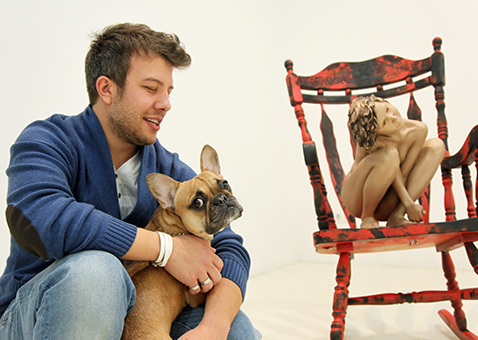wanderlust
Like Artist, Like Animal

I have a little theory when it comes to human/animal relationships. Here, let me test it out: I would like you to create a mental image of your favorite animal––yep, the one that interests you the most. Got it? Okay, now describe the reasons why this animal happens to be your favorite: why does this one stand out to you compared to all the other animals?
Those two questions were the test, now here are the results: chances are the animal you have chosen is your favorite because it reminds you a lot about yourself. Right? You see yourself in this animal; its behavioral characteristics feel familiar to your own. But the truth is that you are not––I’m willing to assume––specialized in ethology (the branch of zoology concerned with the scientific and objective understanding of animal behavior), and the description you gave was really your own perception of your favorite animal’s behavior. In describing an animal that you feel strongly attached to, what you are really doing is describing behavioral characteristics you find in yourself.
We tend to relate to things in the external world that reflect the characteristics of the internal. Our pets, the anthropomorphized animals par excellence, are certainly not the exception. I approached artist Peter Mühlhäußer (sculptor of "Girls") and gallerist Thore Krietemeyer (from our Mehringdamm tour) to chat about their relationship with their animal pets; the whole time they remained unaware that what I really wanted to do was know more about them as individuals. Here are the results.
Peter Mühlhäußer and BumbleBee
BAPs: How did you meet BumbleBee?
PM: We saw photos of BumbleBee on a local breeder's website, and she was so beautiful, but we were hoping her personality would also match our expectations. We had the name picked out, the toys and supplies purchased and everything set up. After visiting Bee and at first sight watching her burst out into the room with energy and a sweet disposition, we knew she was ours instantly. We noticed she had a unique character aside from most dogs—very intuitive and obsessed with understanding everything we were thinking and doing; almost human-like.
BAPs: As one of the people that know her the best, could you describe how BumbleBee is?
PM: Bee is a celebrity amongst those that know her. My wife posts all of her antics on facebook and tons of great photos, so Bee's become quite an entertainer in her own respect. I guess the most notable quality BumbleBee displays is her acute ability to communicate with and manipulate humans. She's not interested in other dogs, as she assumes she is a human herself and associates with them. Bee rolls her eyes and sighs heavily when she has been scolded, as well as when she is bored and not the center of attention. She sleeps in bed with us in the middle, on her back with her head thrown back, and snoring heavily––her paws tipping up with each breath. She performs an abundance of great tricks, is food obsessed, and most of the times grouchy.
BAPs: What’s one of the most memorable experiences you’ve had with her?
PM: Inspired by one of her signature poses (sprawled out on her belly, with arms at sides and feet trailing back like frog legs), I created "Mollie." Mollie is a surrealistic portrait of a heavy girl that shows her exhaustion and is a gestural depiction of the dog pose in the form of a human. During the time while I was sculpting Mollie's face, my wife caught Bee chewing at it one afternoon while I was away. She had devoured the entire face, which induced vomiting! So the face that Mollie currently has is not the original one!
Mühlhäußer will have two of his sculptures exhibited in the show "Personal Structures" at Palazzo Bembo as offical part of the 55th Biennale di Venezia 2013, but you may also catch him exhibiting locally at URBANFUSE during the upcoming Gallery Weekend in Berlin. We hope to see BumbleBee there!
Be the first to write a comment.
Your feedback

